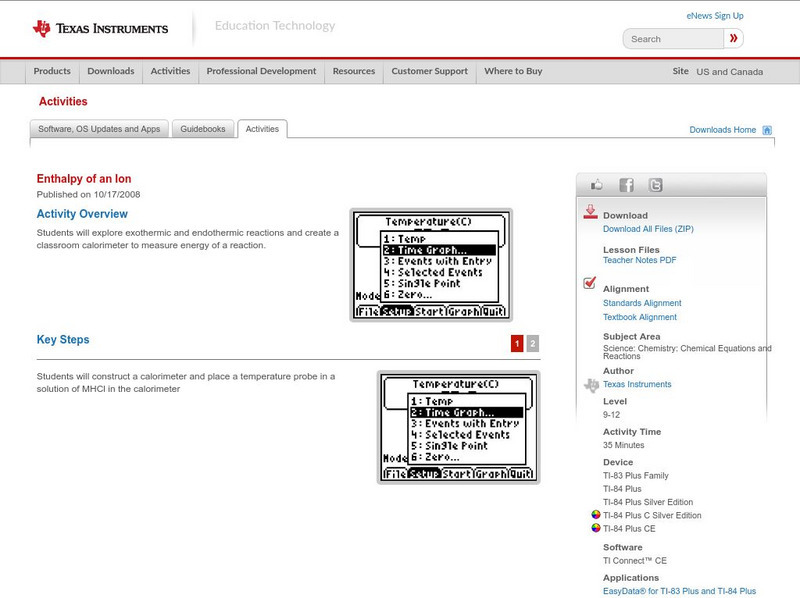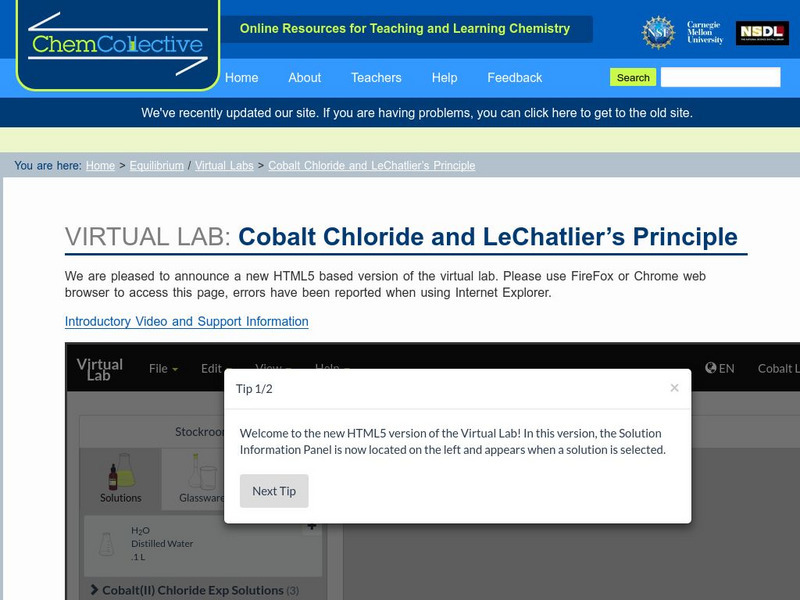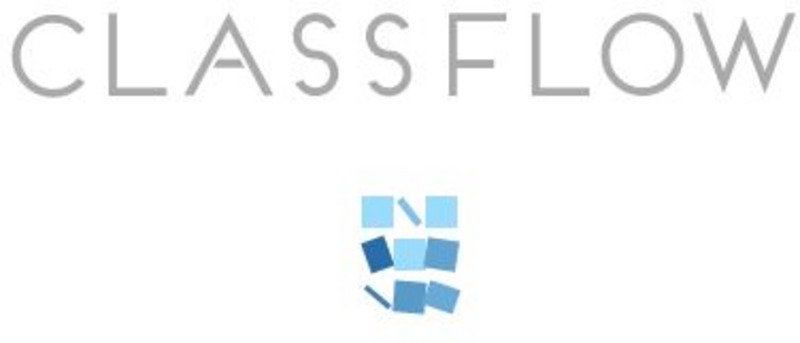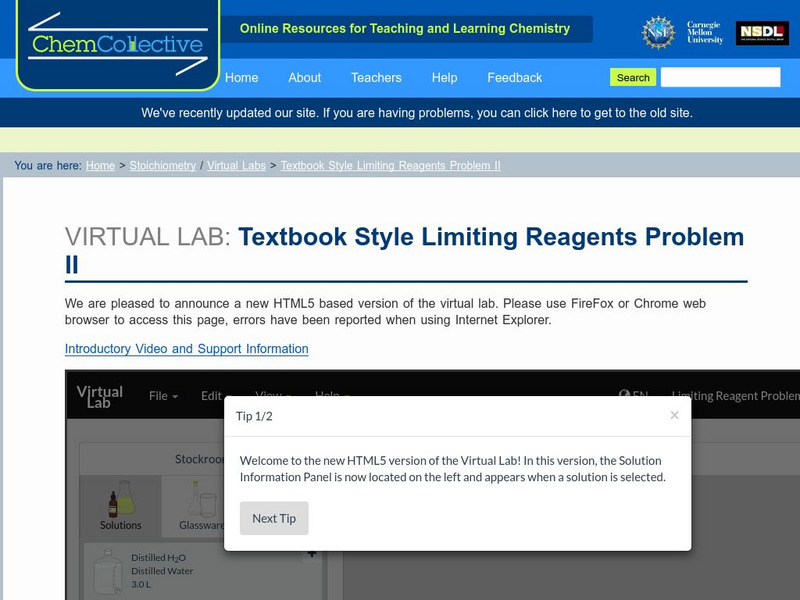Other
Fun Based Learning: Chemistry: Classic Chembalancer
An exercise for students to practice balancing equations. Exercise gives one equation per page and after the students complete the problem it tells them whether their answer is correct or not. A good basic practice for students who need...
Cosmo Learning
Cosmo Learning: Chemistry 1 A: General Chemistry
A collection of video lectures from a general chemistry course taught at the University of California, Berkeley. The course covers topics like stoichiometry, acid-base and solubility equilibrium, oxidation-reduction reactions, chemical...
Other
Diver Ciencia: Quimica Magica
Try eighteen different chemistry experiments which look like magic but everything is a product of chemical reaction.
Concord Consortium
Concord Consortium: Stem Resources: Making Heat
In this activity, students perform a reaction with different concentrations of reactants and monitor the temperature of the reaction. Activity contains procedure, analysis questions, and graph template. Students can save their answers...
Virginia Tech
Types of Equations
After learning about and reviewing the types of chemical equations and rules for balancing, students can practice balancing equations on interactive quizzes.
Texas Instruments
Texas Instruments: Enthalpy of an Ion
In this activity you will: Explore exothemic and endothermic reactions. Create a classroom calorimeter to measure energy of a reaction.
Other
New Mexico State University: Chemical Equilibrium
A one page tutorial which teaches the viewer how to predict and write equilibrium expressions and use them to calculate equilibrium concentrations. Discusses Le Chatelier's Principle.
Chemistry Collective
Chem Collective: Stoichiometry Applet
One of the first numerical problems encountered in introductory chemistry is that of "limiting reagents". This applet serves as a supplement to such calculations, providing imagery that helps students see beyond the rote mathematics.
Vision Learning
Visionlearning: Dalton's Playhouse
Travel back in history and visit the laboratories of Priestley, Lavoisier, and others. Take part in simulations of the experiments which laid the foundation for the scientific field of chemistry. Learn about the discoveries which lead to...
Other
New Mexico State University: Change in Entropy
An example of a calculation of the change in entropy in a simple chemical reaction.
Other
The Science House: Ziptop Bag Chemistry
In this experiment, three reactions are performed in a sealed Ziploc bag so that they can be observed. Students identify whether physical or chemical change has taken place.
Maryland Science Center
Maryland Science Center: Baggie Blast [Pdf]
See what happens when you mix vinegar, water, and baking soda.
American Chemical Society
Middle School Chemistry: Co2 Reacting With Water
See how carbon dioxide reacts with water to produce carbonic acid.
CK-12 Foundation
Ck 12: Chemistry: Conservation of Mass
[Free Registration/Login may be required to access all resource tools.] Describes the law of conservation of mass.
Dartmouth College
Dartmouth College: Qualitative Analysis of Anions
"In this experiment, you will observe the reactions of some simple salts, analyze common household chemicals, and identify an unknown sample by testing its reactivity."
Chemistry Collective
Chem Collective: Cobalt Chloride and Le Chatlier's Principle
In this activity, students safely explore the equilibrium reaction of the cobalt chloride reaction.
ClassFlow
Class Flow: Rates of Change
[Free Registration/Login Required] This is part 4 of a 4 part series to include the nature of chemical reactions, reaction types, and balancing chemical equations.
Frostburg State University
Frostburg State General Chemistry Online: Ionic Dissociation
Slides six and seven of a lecture series illustrate and explain ionic dissociation. These slides are in a group of nineteen slides about chemical reaction in solution.
Frostburg State University
Frostburg State General Chemistry Online: Electrolytes
These are slides eight through ten of a set of slides about Chemical reaction in solution. These slides discuss strong and weak electrolytes, acids, bases, and salts.
Chiral Publishing
Chiral Publishing: An Introduction to Chemistry: Chemical Calculations and Chemical Equations [Pdf]
Slide show focusing on the elements of stoichiometry relating to limiting reactants. Go through the first several slides to review or introduce the topic.
Khan Academy
Khan Academy: The Equilibrium Constant K
Reversible reactions, equilibrium, and the equilibrium constant K. Learn how to calculate K, and how to use K to determine if a reaction strongly favors products or reactants at equilibrium.
Khan Academy
Khan Academy: Calculating Equilibrium Constant Kp Using Partial Pressures
A thorough reference providing the definition of equilibrium constant Kp for gas phase reactions, and how to calculate Kp from Kc.
Chemistry Collective
Chem Collective: Acclimatization on Mt. Everest
To get to the top of the mountain before winter arrives, students must derive an equation that relates the necessary amount of hemoglobin to the partial pressure of oxygen at the current and next camp.
Chemistry Collective
Chem Collective: Textbook Style Limiting Reagents Problem Ii
In this activity, students practice with experiments involving limiting reagents and the test their knowledge to determine the concentration of an unknown solution.
















